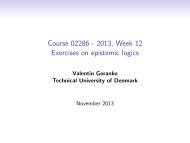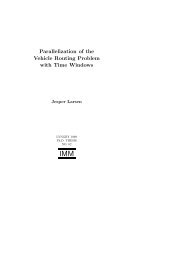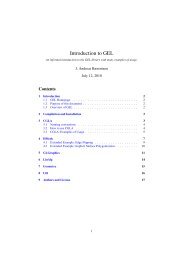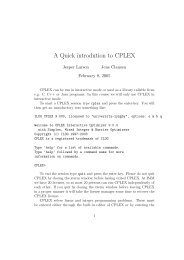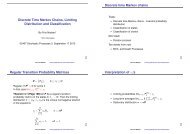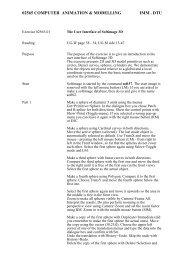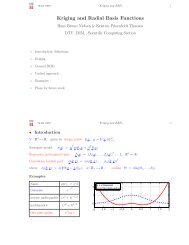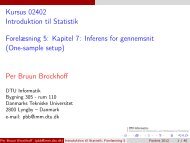A HLSL Primer for Developers
A HLSL Primer for Developers
A HLSL Primer for Developers
- No tags were found...
You also want an ePaper? Increase the reach of your titles
YUMPU automatically turns print PDFs into web optimized ePapers that Google loves.
A <strong>HLSL</strong> <strong>Primer</strong> <strong>for</strong> <strong>Developers</strong>By Wolfgang F. Engel (wolf@shaderx.com)June 13th, 2003
Agenda• <strong>HLSL</strong> by example: projective texturing• Two tricks– Simulating blending operations on floating pointrender targets– Normal Map Compression
Introduction• High-Level Shader Language (<strong>HLSL</strong>) is a language <strong>for</strong> programming GPU‘s• Looks like C• Example vertex and pixel shader <strong>for</strong> projective texturing (texture should appear to beprojected onto the scene, as if from a slide projector)struct VS_OUTPUTPROJTEX // output structure{float4 Pos : POSITION;float4 Tex : TEXCOORD0;};VS_OUTPUTPROJTEX VSProjTexture(float4 Pos : POSITION, float3 Normal : NORMAL){VS_OUTPUTPROJTEX Out = (VS_OUTPUTPROJTEX)0;Out.Pos = mul(Pos, matWorldViewProj); // trans<strong>for</strong>m PositionOut.Tex = mul(ProjTextureMatrix, Pos); // project texture coordinates}return Out;float4 PSProjTexture(float4 Tex: TEXCOORD0) : COLOR{return tex2Dproj(ProjTexMapSampler, Tex);}
Vertex Shader Explanationstruct VS_OUTPUTPROJTEX // output structure{float4 Pos : POSITION;float4 Tex : TEXCOORD0;};• Output structure: vertex shader outputs a position value and a texture coordinate to thepixel shader• Semantics (f.e. : POSITION or : TEXCOORD0)– capital keyword + preceded by a colon (:)– Links shader input to the output of the previous stage of the graphics pipeline– In other words: helps the <strong>HLSL</strong> compiler to bind the data to the right hardware registers– Different Input and output semantics <strong>for</strong> vertex and pixel shaders• Data types:– bool, float, float2, float3, float4, float4x4 (matrix) etc.– int (32-bit integer), half (16-bit float), double (64-bit float) (emulated if not supported)– No string type
Vertex Shader Explanation IIVS_OUTPUTPROJTEX VSProjTexture(float4 Pos : POSITION){VS_OUTPUTPROJTEX Out = (VS_OUTPUTPROJTEX)0;Out.Pos = mul(Pos, matWorldViewProj); // trans<strong>for</strong>m PositionOut.Tex = mul(ProjTextureMatrix, Pos); // project texture coordinates}return Out;• Math Intrinsic functions (converted to instructions by the <strong>HLSL</strong> compiler)– normalize(v) returns normalized vector v/length(v)– pow(x, y) returns x y– saturate(x) clamps x to 0..1– mul(a, b)transpose)multiplies row-vector * matrix or matrix * column-vector (might help to save a– and many more– Math intrinsic functions work in vertex and pixel shaders
Pixel Shaderfloat4 PSProjTexture(float4 Tex: TEXCOORD0) : COLOR{return tex2Dproj(ProjTexMapSampler, Tex);}• Texture sampling intrinsics: 16 tex* <strong>for</strong> 1D, 2D, 3D and cube map texturestex2Dproj(s, t): 2D projective texture lookup by dividing t (4D texture coordinate) through its last component• Output value: float4 : COLORRendering into a multiple render target:struct PS_OUTPUTPROJTEX{float4 Col : COLOR;float4 Col1 : COLOR1;};PS_OUTPUTPROJTEX PSProjTexture(float4 Tex: TEXCOORD0){PS_OUTPUTPROJTEX Out = (PS_OUTPUTPROJTEX) 0;Out.Col = tex2Dproj(ProjTexMapSampler, Tex);Out.Col1 = tex2Dproj(ProjTexMapSampler, Tex);}return Out;
Projective Texturing IssuesThere are two notable issues with projective texturing– Back-projection artifacts: projects texture on surfaces behind the projectorReason: undefined negative results from texture interpolatorsSolution: Tex.w < 0.0 ? 0.0 : tex2Dproj(ProjTexMapSampler, Tex)– projective texture is applied to every triangle (front and back) that is within the projectors frustrumReason: No occlusion checksSolution #1: Restrict projection to front facing triangles by comparing a dot product between theprojectors direction and the normal to 0.0.VS_OUTPUTPROJTEX VSProjTexture(float4 Pos : POSITION, float3 Normal : NORMAL){VS_OUTPUTPROJTEX Out = (VS_OUTPUTPROJTEX)0;Out.Pos = mul(Pos, matWorldViewProj);// trans<strong>for</strong>m PositionOut.Tex = mul(ProjTextureMatrix, Pos); // project texture coordinatesfloat4 PosWorld = normalize(mul(Pos, matWorld)); // vertex in world spaceOut.Norm = normalize(mul(Normal, matWorld));// normal in world spaceOut.Proj = PosWorld - normalize(vecProjDir); // projection vector in world spacereturn Out;}float4 PSProjTexture(float4 Norm : TEXCOORD0, float4 Tex: TEXCOORD1, float4 Proj : TEXCOORD2): COLOR{if (dot(Proj, Norm)
Demo
<strong>HLSL</strong> Features from C• <strong>HLSL</strong> provides structures and arrays incl. Multidimensional arrays• Comments (//, /* */)• All C‘s arithmetic operators (+, *, /, etc.)• bool type with bolean and relational operators (||, &&, !, etc.)• Increment/decrement (++, --)• Conditional expression (? :)• Assigment expressions (+=, etc.)• C comma operator• User defined functions (not: recursive functions)• A subset of C‘s flow constructs (do, while, <strong>for</strong>, if, break, continue) Not: goto, switch• #define, #ifdef etc.
Additional <strong>HLSL</strong> Features not in C• Built-in constructorsfloat4 vec = float4(4.0, -2.0, 5.0, 3.0);• Swizzlingfloat4 vec1 = float4(4.0, -2.0, 5.0, 3.0);float2 vec2 = vec1.yx; // vec2 = (-2.0, 4.0)float scalar = vec1.w; // scalar = 3.0float3 vec3 = scalar.xxx; // vec3 = (3.0, 3.0, 3.0)• Write maskvec1.xw = vec3; // vec1 = (3.0, -2.0, 5.0, 3.0)• Matrices can be stored as row_major or column_majorrow_majorcolumn_majorrow_majorcolumn_majorhalf1x4 fh1By4;half1x4 fh4By1;half3x2 fh3By2;half3x2 fh2By3;Or as compiler pragmas#pragma PACK_MATRIX (ROW_MAJOR)#pragma PACK_MATRIX (COLUMN_MAJOR)• The keyword register can be used to specify a specific registerfloat4 vDisplace : register (c0); // puts vDisplace constant into C0• Restrict the usage of specific registers on specific versionsfloat4 vDisplace : register(ps_2_0, c10) // puts vDisplace into C10 <strong>for</strong> ps_2_0
C Features not Supported in <strong>HLSL</strong>• No pointers/bitwise operations• No unions and function variables• No classes, templates, operator overloading, exception handling, and namespaces• No string processing (no string type), file i/o, memory allocationNot the scope of <strong>HLSL</strong>
What‘s required <strong>for</strong> Compilation• Entry point: name of vertex shader or pixel shader• Compile target: vertex or pixel shader versionVersion Inst. Slots Constant Count====== ======== ===========vs_1_1 128 at least 96 cap'd (4)vs_2_0 256 cap'd (4)vs_2_x 256 cap'd (4)vs_2_sw unlimited 8192vs_3_0 cap'd (1) cap'd (4)ps_1_1 - ps_1_3 12 8ps_1_4 28 (in two phases) 8ps_2_0 96 32ps_2_x cap'd (2) 32ps_2_sw unlimited 8192ps_3_0 cap'd (3) 224ps_3_sw unlimited 8192(1) D3DCAPS9.MaxVertexShader30InstructionSlots(2) D3DCAPS9.D3DPSHADERCAPS2_0.NumInstructionSlots(3) D3DCAPS9.MaxPixelShader30InstructionSlots(4) D3DCAPS9.MaxVertexShaderConstExample command line:• fxc.exe /T ps_2_0 /E PSProjTexture /Fc test.txt $(InputName).fx<strong>HLSL</strong> compiler compile Target Entrypoint output assembly file name of input file• Effect file framework helps managing shaders and helps to provide fallback pathes: Recommended !
Trick 1: Blending on Float RTs• Trick by Francesco Carucci, „Simulating Blending Operations on Floating Point RenderTargets“, ShaderX 2 – Shader Tips & Tricks, August 2003, Wordware Ltd.• Simulating blending operations on floating point render targets• How does it work:– Pass 1: Setup floating point texture as render target and then render into it– Pass 2:• send vertex position in camera space from the vertex shader through the interpolators to the pixel shader• trans<strong>for</strong>m vertex position into screen space in the pixel shader• Blend fp texture with the result of this pass• Reading in the input texture in the pixel shader (Pass 2)– send vertex position in camera space from the vertex shader through the interpolators to the pixelshaderVS_OUTPUTPROJTEX VSProjTexture(float4 Pos : POSITION, float3 Normal : NORMAL){VS_OUTPUTPROJTEX Out = (VS_OUTPUTPROJTEX)0;float4 Position = mul(Pos, matWorldViewProj); // trans<strong>for</strong>m PositionOut.Tex = mul(ProjTextureMatrix, Pos); // project texture coordinatesOut.Pos = Position;}Out.Tex2 = Position;return Out;// provide vertex position in camera space
Trick: Blending on Float RTs II– trans<strong>for</strong>m vertex position into screen space in the pixel shaderfloat4 tex2DRect(sampler2D s, float4 position)// user-defined function{float2 tc;tc.x = (position.x / position.w) * 0.5 + 0.5;tc.y = (-position.y / position.w) * 0.5 + 0.5;}return tex2D(s, tc);– Blend values:// -------------------------------------------------------------// Pixel Shader (input channels):output channel// -------------------------------------------------------------float4 PSProjTexture(float4 Tex: TEXCOORD0, float4 Position : TEXCOORD1) : COLOR{float4 TexProj = tex2Dproj(ProjTexMapSampler, Tex);float4 TexRenderMap = tex2DRect(RenderMapSampler, Position);return TexRenderMap * TexProj;// blend}
Trick 1: Blending on Float RTs III• Does not support blending modes with a destination color computed in the samepass (f.e. particle system)• Watch out <strong>for</strong> color saturation -> map to 0..1 with a logarithmic function• Fillrate: 64-bit or 128-bit render targets burn fillrate.
Trick 2: Normal Map Compression• Trick by Jakub Klarowicz, „Normal Map Compression “, ShaderX 2 – Shader Tips& Tricks, August 2003, Wordware Ltd.• Geometry details in bump maps (ATI Normal Mapper or NVIDIA Melody) needhigh resolution maps-> big chunk of memory• How does it work:– Use all four color channels of DXT5 <strong>for</strong>mat– One channel of the normal map (R, G or B) is copied into alpha channel A and then it iscleared (filled with zero values) (f.e. with Adobe Photoshop)– The alpha channel is copied back into the color channel in the pixel shader• Why does it work:– Alpha channel is quantized separately from the RGB channels– Alpha channel is quantized with an increased accuracy– Clearing one color channel leads to a higher precision in quantization of the colorchannels• Pixel Shader source:…float4 bumpNormal = 2 * (tex2D(BumpMapSampler, Tex) - 0.5); // bump mapbumpNormal.g = bumpNormal.a;// move alpha into green color channel…
Trick 2: Normal Map Compression II• Does not work well <strong>for</strong> model space normal maps as <strong>for</strong> tangent space maps-> vectors in model space normal maps vary much• Rough normal maps still look bad when compressed
Trick 2: Normal Map Compression IIIFigure: Left DXT5 compressed (2049 kb) | Right: uncompressed (8183 kb)
Wrap Up• <strong>HLSL</strong> ~ C with modifications <strong>for</strong> Graphics• <strong>HLSL</strong> compiler optimizes <strong>for</strong> hardwarefrom different vendors• Use it … don‘t invest time to learnassembly
Further Reading• Jason L. Mitchell, Craig Peeper,„Introduction to <strong>HLSL</strong>“, ShaderX 2 – ShaderIntroduction & Tutorial, August 2003,Wordware• Cass Everitt, „Projective Texturing“,NVIDIA developer web-site.
Thank you



